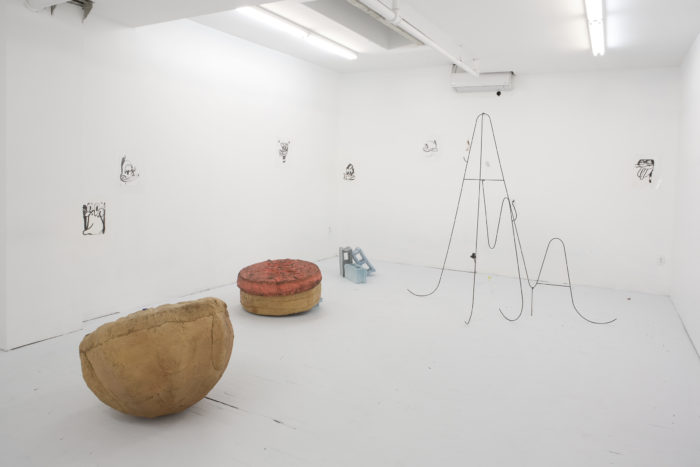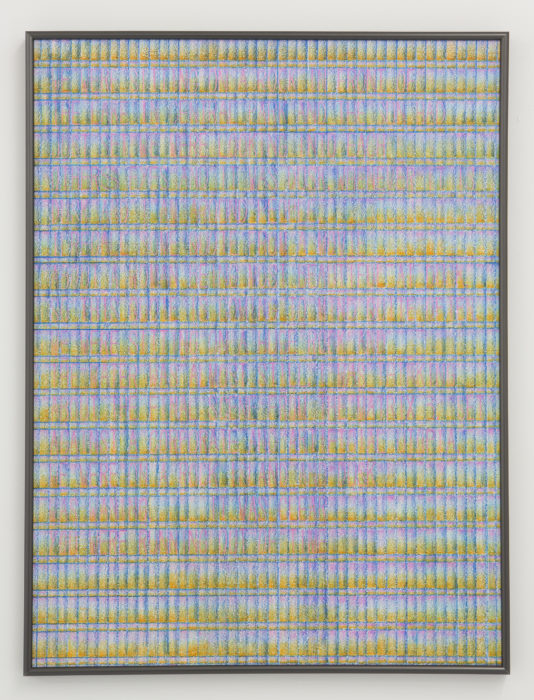“There’s an economy to emotional expression,” says Lex Brown, when speaking by phone of her desire to “de-internalize racism and sexism.” The New York-based artist’s fluency in expressive economies is evidenced in her artworks, which deftly balance a sense of comedy that is dark and vaudevillian with the strength of her subjectivity – a counterpoint on which the other elements turn. Materially, her works encompass performance, sculpture, writing (her erotic novel My Wet Hot Drone Summer is available through Badlands Unlimited), video, and, most recently, drawing.

Brown’s first solo exhibition Immortal Duck, which ran at New York’s Deli Gallery from June 9 to July 9, presented an unruly group of fluid ink-on-paper renderings of the classic Looney Tunes character Daffy Duck. Alongside a number of sculptural works that pull their power through the vernacular of the support structure, a pair of densely geometric colored pencil on paper drawings conceal the artist’s diaristic texts on a romantic encounter in Central Park, as well as women in Hollywood movies. While Immortal Duck owes its pacing to the energetic and linguistic elements present in her drawings, much of Brown’s previous work has accomplished this through in situ performance. Having studied clowning techniques, the artist’s searing performances similarly draw upon pop cultural and autobiographical references, while they employ musico-theatrical forms that run from operetta to RnB.
Between the close of Immortal Duck and the upcoming presentation of her new video ‘Lip Gloss Alurt’ on the Highline Channel opening on September 28, Brown spoke with AQNB about her work, and her relationship with cartoons which resonate in their portrayal of an elastic reality.
Lex Brown: My work is rooted in an appraisal of what energy I need to grow at any given time. I’m feeling a sense of beginning again, so I was mining things from childhood and watching a lot of Daffy Duck videos. I realized that he, as a character, is such a clown, specifically a clown in the way that I have been studying clowning as a performance technique and tradition.
More than any of the other Looney Tunes characters, Daffy embodies so many different personas and roles. He’s kind of manic and his emotions are always fluctuating wildly. Those fast-paced fluctuations between highs and lows are a strategy that I use in my performances a lot – to go on a real up-and-down with the audience.
The title of the show, Immortal Duck, references a series called ‘The Hunting Trilogy’ where Elmer Fudd shoots Daffy Duck 18 times within three episodes, but Daffy never dies. He can’t die because he’s needed – Fudd would have nothing more to shoot at. That Daffy Duck is the one with real power had a personal resonance for me. There is something so truthful to me about cartoons in the way that they portray an elasticity to reality. I wanted the whole show to have a relationship to the rhythm and look of cartoons.

** Could you speak to the relationship between your object-making and your performances?
LB: Before I started performing I was making installations based around characters. I also made sculptures that had a performative relationship to language. As I got into performing, I focused less on the objects and more on language, sound, and sequence.
I’ve always had a fascination in the body as an object that is embodied by a spirit, and also how others objectify a given body. I have an acute sense of double-consciousness and often perceive myself as if from looking from the outside. I got to a point where I was ready to build more of that complexity into the work. The objects that I’m using now my are made as sculptures and serve as characters, objects, and places. They can be read and experienced independently of performance, or interdependently between works.
After the experience of a performance has passed, you can sometimes feel like you’re left with nothing. So it’s also nice to have this process of making something physically tangible. And, no one ever wants to talk about this, but I have to support my performance work.

** There was no performance associated with your recent solo show Immortal Duck. Why?
LB: I thought I was going to do one, but I realized I needed to take a break and give myself a chance to show drawings and sculptures. I’ve never shown any drawings before. As scary as it would be for some people to stand up in front of 130 people and perform, it was that scary for me to show those colored pencil drawings.
** Tell us about your interest in food, especially in rage burgers.
LB: Food is a very efficient way of representing larger systems like economy and nationality, but there’s also a level of humor to it. I think because we all eat food and most of us love food. Whenever I hear food is anywhere, I’m there. The relationship I have with food is a privilege.
One review in Art Forum talked about how the image in relief on the bun looked like the word “race.” I was aware that would be an interpretation, but it does say “rage” in relief. The word emerged as I thought about an emotional counterpoint to the text drawing which is very much a text about romance and intimacy, amongst other things (visibility, architecture, race, The Matrix 3). Visually, I find the word “RAGE” very strong. I wanted the word on the burger to have some thematic relationship to ‘Focacciatown,’ my first major performance. More generally, I wanted the word to make a relationship with the iconic American food, the burger, that it’s emerging from. As I worked on it, my own associations with that word came up, and some of those have to do with being black and being a woman.

** Not only have you written a book for Badlands, but writing is everywhere in your practice. What is your relationship to writing?
LB: I think about myself as a writer in the same way that I think about myself as a performer. It’s not an activity that I do, but a way in which I inhabit the world. In the sense that fiction creates realities, it’s very important to work in fiction and with fiction. Theatre and performance combine so many essential parts of being human, of gathering together to look at the performance of reality. But we also live in theatre: you play the part of yourself day-to-day. Land developers create cities as sets for societies to live in. I suspect that the era we live in is so scripted by the movies, especially when it comes to technology. I couldn’t function without writing, since language is the most immediate way to manifest something into reality. **













